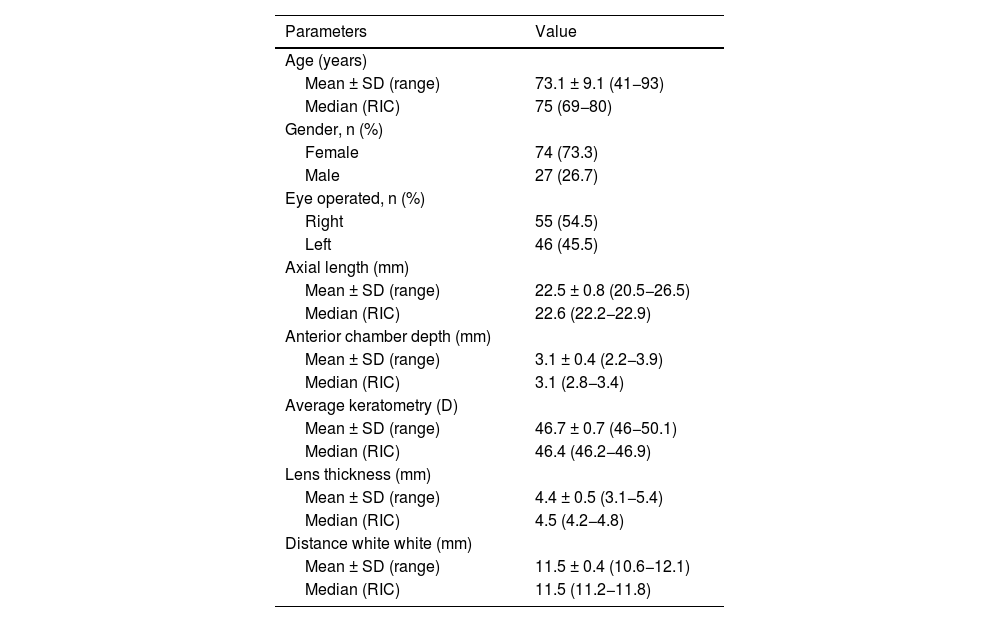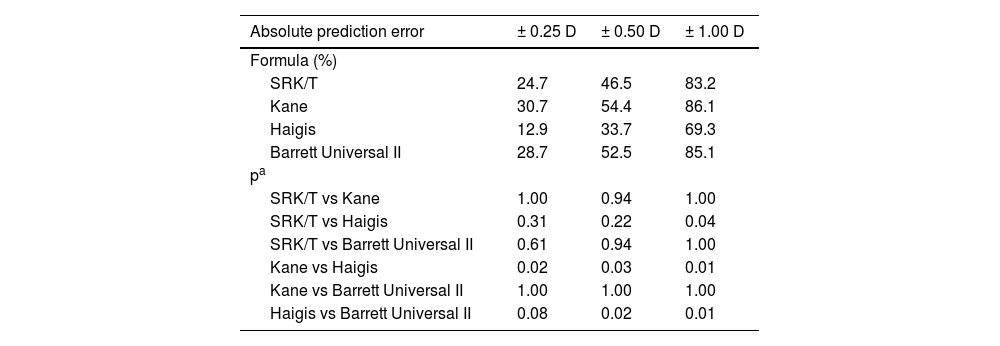To compare the accuracy of Kane, Barrett Universal II, Haigis, and SRK-T formulas in eyes with average keratometry greater than 46 diopters (D).
MethodsA retrospective analysis was conducted on 101 eyes of 101 patients with average keratometry greater than 46 D. The absolute prediction error (EA) was obtained for each patient one month after surgery. The mean absolute prediction error (MEA), median absolute prediction error (MedEA) and the percentage of patients with absolute refractive error less than 0.25 D, 0.50 D, and 1.00 D were calculated for each formula analyzed.
ResultsThe Kane formula achieved the lowest MEA (0.53 ± 0.43) and the lowest MedEA (0.41), followed by Barrett Universal II (MEA: 0.56 ± 0.42, MedEA: 0.49), SRK-T (MEA: 0.59 ± 0.44, MedEA: 0.54), and Haigis (MEA: 0.77 ± 0.47, MedEA: 0.69), showing a significant difference in the results. It was also observed that the Kane formula was the most accurate, with the highest percentage of patients, with EA less than 0.25 D, 0.50 D, and 1.00 D (30.7%, 54.4%, and 86.1%, respectively), while the Haigis formula was the least accurate (12.9%, 33.7%, and 69.3%, respectively).
ConclusionIn eyes with corneas having average keratometry greater than 46 D, the Kane formula proves to be a useful tool in intraocular lens (IOL) power calculation and demonstrates higher precision compared to the Barrett Universal II, SRK-T, and Haigis formulas.
Comparar la precisión de las fórmulas Kane, Barrett Universal II, Haigis y SRK-T en ojos con queratometrías promedio mayores a 46 dioptrías (D).
MétodosSe analizaron de forma retrospectiva 101 ojos de 101 pacientes con queratometrías promedio mayores a 46 D, se obtuvo el error de predicción absoluto (EA) de cada paciente al mes de su cirugía y se calcularon la media del error de predicción absoluto (MEA), la mediana del error de predicción absoluto (MedEA) y el porcentaje de pacientes con EA menor a 0.25 D, 0.50 D y 1.00 D para cada una de las fórmulas a analizar.
ResultadosLa fórmula de Kane obtuvo la menor MEA (0.53 ± 0.43) y la menor MedEA (0.41), seguida de Barrett Universal II (MEA: 0.56 ± 0.42, MedAE: 0.49), SRK-T (MEA: 0.59 ± 0.44, MedEA: 0.54) y Haigis (MEA: 0.77 ± 0.47, MedEA: 0.69), mostrando una diferencia significativa en el resultado. Se observó también que la fórmula Kane fue la más precisa, obteniendo el mayor porcentaje de pacientes con EA menor a 0.25 D, 0.50 D y 1.00 D (30.7%, 54.4% y 86.1% respectivamente) y la fórmula Haigis la menos precisa (12.9%, 33.7% y 69.3% respectivamente).
ConclusiónEn ojos con córneas con queratometrías promedio mayores a 46 D, la fórmula Kane es una herramienta útil en el cálculo de lente intraocular (LIO) y muestra mayor precisión comparada con las fórmulas de Barrett Universal II, SRK-T y Haigis.











